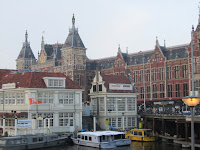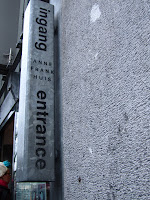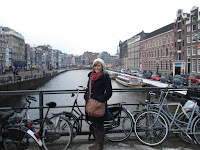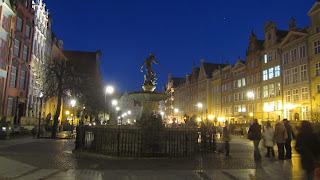 |
| our first night in Liege |
After we reached Brussels, Roberto and I separated from Momo and went with his mom and sister to his city, Liege. The night we got there, after a quick meal, we went into the city center with Roberto's friend, Thomas, and went to a pub the boys part own. We had a great time and slept almost all of the next day!
So we flew into Belgium on the 22 of December... the 23 was a recuperation day and the 24 was Christmas Eve.
 |
| Christmas dinner |

 The next day the whole house was asleep until well into the afternoon. We just had a late lunch of leftovers with the closer family and relaxed. We went into the city and went to "Village de Noel" or the Christmas Village. Mulled (hot) wine is a popular winter drink all over Europe. I neglected to mention that while in Prague, mulled wine was the only reason we survived the cold. So in Liege we drank our hot wine and just relaxed at a friends place and after some creative driving, headed home.
The next day the whole house was asleep until well into the afternoon. We just had a late lunch of leftovers with the closer family and relaxed. We went into the city and went to "Village de Noel" or the Christmas Village. Mulled (hot) wine is a popular winter drink all over Europe. I neglected to mention that while in Prague, mulled wine was the only reason we survived the cold. So in Liege we drank our hot wine and just relaxed at a friends place and after some creative driving, headed home.I think I have mixed up my days a little bit here, but I am not too sure of the order.
One day... while we were in Liege... we went sledding and it was toooooo much fun! Belgium kind of lacks... hills. So after a decent amount of driving we reached the hill and had a fun day in the snow :)
The next day we went through the city and explored a bit, checking out the Christmas market and had a nice relaxing night before we went to...
AMSTERDAM
I love Amsterdam, I really do.
 We woke up early and caught a train out of Maastricht. Liege is close to the Dutch border and so Roberto's mom drove us there and we took a cheaper train into Amsterdam. By cheap I mean... in Euro's terms. Converted to zloty it seemed way too expensive for a train. But we caught a train and made it to Amsterdam that afternoon.
We woke up early and caught a train out of Maastricht. Liege is close to the Dutch border and so Roberto's mom drove us there and we took a cheaper train into Amsterdam. By cheap I mean... in Euro's terms. Converted to zloty it seemed way too expensive for a train. But we caught a train and made it to Amsterdam that afternoon. My first thoughts of Amsterdam... it was cold. jajaja... when touring a city in the winter be prepared to freeze. It was cold... and beautiful. The train station (after living in Poland) was amazing. Unfortunately we didn't have time to do an official tour as it was off season for tourists and we had less than 24 hours. So our first order of business was to buy gloves.
My first thoughts of Amsterdam... it was cold. jajaja... when touring a city in the winter be prepared to freeze. It was cold... and beautiful. The train station (after living in Poland) was amazing. Unfortunately we didn't have time to do an official tour as it was off season for tourists and we had less than 24 hours. So our first order of business was to buy gloves.Following a quick trip through H & M we explored. The first thing I really noticed was the way the shops were organized. It went restaurant restaurant "coffee shop" "coffee shop" hookah bar (nargile in Turkey) restaurant. As you should know... a coffee shop is a cannabis shop... as cannabis, along with prostitution, is legal in Holland.
We then set off in search of Roberto's cousin's boyfriend's (fiance's?) office. Which we found, after... quite some time. He then gave us a few recommendations then we continued our adventure. After a short while we found the apartment and ate a really, really delicious meal...
 We then set off to find the red-light district. Disturbing but an important part of Amsterdam. The whole street was lined with "shop windows" that... usually men... could walk past and do some... window shopping... I hope you can pick up what I am trying to explain. See the photos to understand... We then made our way a bit farther into the center (FAMILY, STOP READING) and stopped at a hookah bar and a coffee shop... My friend from home, Megan, had been to Amsterdam summer 2010 and recommended this place called "Lost in Amsterdam" and so Roberto and I decided to stop there. It was awesome... all these cushions on the floor, low tables set up, chill music... it was amazing. Needless to say we had a good, relaxing night in Amsterdam and headed back to Roberto's cousin's flat for a good night's sleep.
We then set off to find the red-light district. Disturbing but an important part of Amsterdam. The whole street was lined with "shop windows" that... usually men... could walk past and do some... window shopping... I hope you can pick up what I am trying to explain. See the photos to understand... We then made our way a bit farther into the center (FAMILY, STOP READING) and stopped at a hookah bar and a coffee shop... My friend from home, Megan, had been to Amsterdam summer 2010 and recommended this place called "Lost in Amsterdam" and so Roberto and I decided to stop there. It was awesome... all these cushions on the floor, low tables set up, chill music... it was amazing. Needless to say we had a good, relaxing night in Amsterdam and headed back to Roberto's cousin's flat for a good night's sleep.  The next day we woke up early and headed on our way. Our first stop was the Anne Frank House. (for more information on Anne Frank visit this site: http://en.wikipedia.org/wiki/Anne_Frank) We had to get there as early as possible because it is such a popular place to visit in Amsterdam and people start queuing up early. When we got out the queue was around the corner! I think everyone knows who Anne Frank is. A German born Jew who escaped to Amsterdam in 1933 when the Nazi's took over. Following the Nazi take over of Amsterdam they were trapped and eventually had to go into hiding. When they were ratted out the whole family was sent to various concentration camps. Anne and her sister survived until March 1945 when they died of typhus. When Otto Frank came home, having survived the camps, he came to an empty, ransacked home. Within a short time, the house was opened to the public as a reminder of what some people in WWII had to live through. Because I had visited Auschwitz on a previous occasion visiting here really struck a chord. Why? Because I had seen what happened to people once they were imprisoned or taken captive. It was brutal... and to seen the living conditions before hand was so difficult. Growing up I had read the Diary of Anne Frank,and the story that seemed so distant at first became glaringly real when I stepped into the attic of that house.
The next day we woke up early and headed on our way. Our first stop was the Anne Frank House. (for more information on Anne Frank visit this site: http://en.wikipedia.org/wiki/Anne_Frank) We had to get there as early as possible because it is such a popular place to visit in Amsterdam and people start queuing up early. When we got out the queue was around the corner! I think everyone knows who Anne Frank is. A German born Jew who escaped to Amsterdam in 1933 when the Nazi's took over. Following the Nazi take over of Amsterdam they were trapped and eventually had to go into hiding. When they were ratted out the whole family was sent to various concentration camps. Anne and her sister survived until March 1945 when they died of typhus. When Otto Frank came home, having survived the camps, he came to an empty, ransacked home. Within a short time, the house was opened to the public as a reminder of what some people in WWII had to live through. Because I had visited Auschwitz on a previous occasion visiting here really struck a chord. Why? Because I had seen what happened to people once they were imprisoned or taken captive. It was brutal... and to seen the living conditions before hand was so difficult. Growing up I had read the Diary of Anne Frank,and the story that seemed so distant at first became glaringly real when I stepped into the attic of that house.  We then began our search for the I AMSTERDAM sign. That wasn't easy because it is moved around. But we found it! Then it was time for a quick lunch and a sprint to catch our train back to Maastricht where Roberto's mom picked us up at the train station and drove back to Liege!
We then began our search for the I AMSTERDAM sign. That wasn't easy because it is moved around. But we found it! Then it was time for a quick lunch and a sprint to catch our train back to Maastricht where Roberto's mom picked us up at the train station and drove back to Liege! The day we got back Momo came to Liege so that we could get back to the Charleroi airport together. That night we went out in Liege and didn't quite make it all the way back to Roberto's and crashed on one of his friend's floor... squished on a variety of mattresses. As Momo would say "it's an experience". It was fun.
The day we got back Momo came to Liege so that we could get back to the Charleroi airport together. That night we went out in Liege and didn't quite make it all the way back to Roberto's and crashed on one of his friend's floor... squished on a variety of mattresses. As Momo would say "it's an experience". It was fun. Before we went to the pub that day we went out for an absolutely amazing meal, typical of Belgium. It was... amazing. The boys said it was some kind of pork... thing. And... OH MY GOD. It was spectacular. That was when they started making me drink... every (I swear) type of beer Belgium has ever produced.
That day we made it back home, packed up... and headed for the airport :)...
There are plenty more stories to share from my time in Liege and Amsterdam... but this post is plenty long enough as is!
I want to extend a sincere and heartfelt thank you to Roberto and all of his family and friends for not only opening their homes and holidays to me, but making me feel so welcome while being there. Being so far from home over a time that is normally one to be spent around friends and family... it was so nice to be some where warm and so full of love... So thank you all, so much...
So, that's how I celebrated Christmas 2010... I can only wonder what 2011 will bring :))
xoxo from Turkey
So, that's how I celebrated Christmas 2010... I can only wonder what 2011 will bring :))
xoxo from Turkey
























